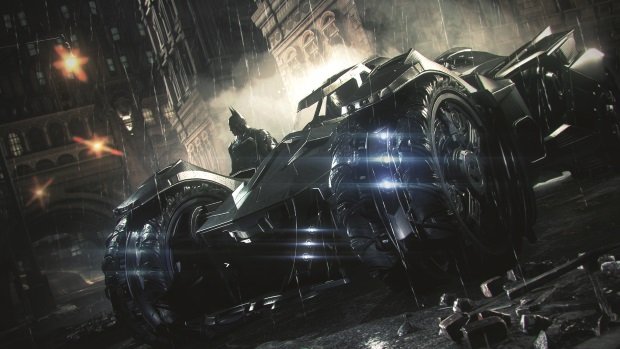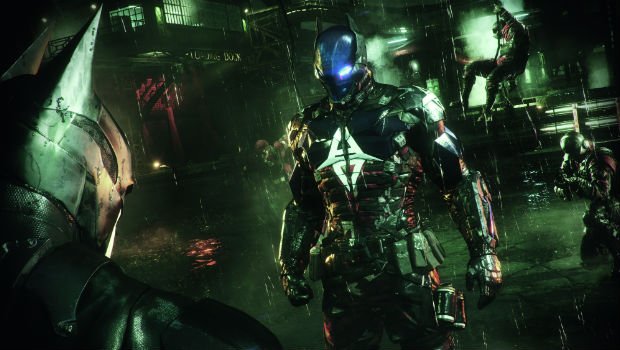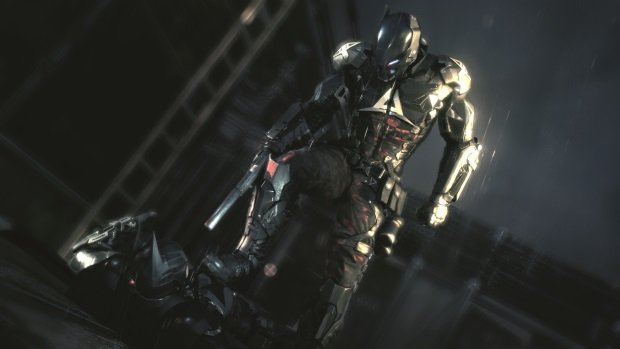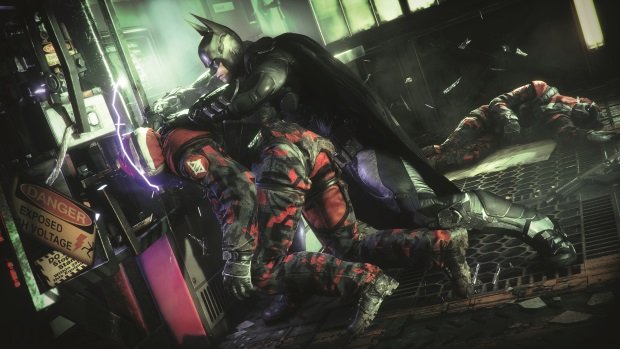Batman: Arkham Knight - the superhero game for a new generation

Arkham Knight game director Sefton Hill is in reflective mood. He and his team are on the home stretch, in the final six months of work on the final game in the trilogy that made their studio’s name. Rocksteady has been making Batman games for eight of its ten years in business. One day next spring, Hill will wake up and it will all be over.
“It dawned on me the other day that we’re going to finish,” he tells us in the boardroom of Rocksteady’s North London offices. “It’s going to be really weird. It’s going to be like a marriage breakup or something, because I’m sort of obsessed with it. I wake up in the morning and it’s the first thing I think of. When I’m speaking to someone, if you could Ctrl-Alt-Delete my brain, my system resources are always 90 per cent making this game and ten per cent having a conversation.”
Hill has less than six months to work out what to engage the bulk of his grey matter with next. He has ideas already, though none are being worked on yet. Rocksteady is, unusually for a studio of its size, a one-project operation, its 160 staff focused solely on laying this trilogy to rest. The prospect of moving on may be unsettling, but it has also been liberating for Arkham Knight’s creators. “We didn’t want to leave any stone unturned; we wanted to put everything in,” Hill says. “That’s always been our attitude, to be honest. We make every game like it’s the last game we’re ever going to make.”
Playing it – and we are the first outside of Rocksteady and Warner to do so – you can see his point. Batman’s existing moveset has been both refined and expanded, his utility belt and toolset has grown too, and he will put all of it to use in the biggest, most detailed world that Rocksteady has ever created. That alone might be a fine way to say goodbye, but not for Hill. Arkham Asylum was about stealth and combat; City added freedom and flowing means to traverse open spaces. Mere refinement of existing systems is not the way Rocksteady works. There has to be something else.
The Batmobile is the answer, and it feels weird to be behind its wheel at first. It should, really. After all, it is an almost indestructible, remotely controllable tank-cum-supercar, and we’re guiding it around the modest courtyards and tight corners of Gotham’s Ace Chemicals facility. It seems an odd choice for a demo: the Batmobile, surely, was built for the open road, a necessary inclusion as Rocksteady expands its take on Gotham to encompass a space five times the size of Arkham City, giving players an alternative to endlessly grapple-boosting the Caped Crusader across miles of open world. In fact, Hill explains, Rocksteady came at it the other way round.

“It was never a case of us wanting to build a bigger Gotham,” he tells us. “For us, it’s about richness and detail, life and feel. It’s not about size; it was never really a consideration when we made City, and it’s not really a consideration here. It was more about what we wanted to introduce, and the Batmobile was there right at the start. We had some cool ideas.”
He’s not wrong. Yes, you can use the Batmobile to cover a lot of ground in a short space of time, and deploy its mounted weaponry to clear out a roadside threat, but Rocksteady has gone further than that, building the car in the same way it has designed every new addition to the Arkham series as it has progressed. It is made to complement, not surmount. “That’s always been very important,” says player code director Adam Doherty, who has worked on all three Arkham games and understands Rocksteady’s Batman as well as anyone.
Sign up to the GamesRadar+ Newsletter
Weekly digests, tales from the communities you love, and more
“One of our core goals was that we didn’t want to put in a Batmobile that was just there for shooting sections, or getting from A to B.”
For all that we’d have loved to have put it through its paces on the open road, Ace Chemicals is the Batmobile’s ideal debut, an opportunity to show how it has been built first and foremost to serve Batman, not shunt him off centre stage.
It’s why, during one combat section with the Batmobile parked nearby, a new button prompt appears. We press X and Square and dragon punch an opponent into the air before the Batmobile knocks him back to the floor again with a tranquilliser round to the head. Outside of brawls, a built-in winch pulls down heavy doors to let our hero enter new areas, and raises and lowers a broken lift to lead him to hostages. The Batmobile is never more than a button press away from being at our side, and during puzzle sections we find ourselves switching constantly, and fluidly, between the Dark Knight and his vehicle.

“We worked to make sure it feels like it was always part of Batman’s universe,” Hill explains. “It doesn’t disrupt the original core set of moves; it totally integrates with them and really becomes part of Batman. They’re not really separate entities. It’s the ultimate gadget.” Its remote control sits in the same radial menu as the Batarang and Batclaw, positioning it as an extension of Batman’s core abilities, designed to give more options within existing systems, not simply add a whole new one on top of them.
Even when the focus is squarely on the Batmobile, it sticks to house style. Squeeze L2 and it switches to Battle mode, the left stick making it strafe instead of steer, the right trigger shooting instead of accelerating, taps of X performing quick directional boost dodges. Later, we’ll learn that Battle mode is ideal for navigating tight spaces, but we’ve got rather more pressing concerns at the moment. Facing off against a courtyard full of drone tanks, we’re told that clean play is as rewarded here as it is in melee combat; a translucent line shows the enemy’s intended line of fire, and it glows red a moment before a shot is fired. While perhaps not as elegant, and certainly not as intuitive, as throwing punches, Batmobile combat is still a balance of attack and defence, of dispatching a screenful of enemies without taking so much as a scratch. After two or three too many retries, it all clicks into place, and a flawless fight concludes with us double-tapping a face button so that the final two drones fall to our homing missiles. Longer combos will yield more powerful weaponry still. And just as in any Arkham game, enemies that require specific tactics to bring down soon arrive to complicate matters. One later in our demo fires three rounds at once in a forked pattern, and can only be damaged with weakspot strikes from your cooldown-managed grenade launcher. It is a very Rocksteady approach to vehicular combat, and it works.
Yet the Batmobile posed a challenge to many more people than just those designing it. In fact, it has impacted on just about every other area of the game. A supercar demands a vast network of roads; a tank demands that they be wide. As such, Arkham Knight not only had to zone out a larger portion of Gotham, but its structures had to grow taller to match the scale of the streets. The enemy threat had to be ramped up to account for a vehicle that takes no damage from falls, collisions or small weapons fire, hence the presence of the titular Arkham Knight and his invading drone army. The audio team had to come up with a convincing engine sound for a vehicle that does not exist. And Batman himself had to be tweaked to ensure players didn’t feel Rocksteady was closing out the trilogy by toning him down. Out in the world, an extra upgrade for Arkham City’s grapple boost flings you higher and faster than before, while taller buildings mean you can pick up more speed by diving, covering longer distances quickly.
“Batman’s not been nerfed to make the car more powerful. In fact, he’s been buffed. We’ve got a really nice balance,” Hill tells us. “Internally, we have some people who use the car a lot more, and some who use the gliding more. It’s up to the player. I’m playing the game a lot at the moment – it’s a lovely stage of the project: you’re just playing, reviewing, writing up lists of tasks – and I constantly switch up the way I play. I’m not doing it to test the game, I’m doing it because I enjoy it. If I ever find I’m erring too much on one side, then obviously we’re doing something wrong.”
It is an open-world parallel to the balance Rocksteady strikes between combat and stealth, giving you options and only occasionally insisting that you use one or the other. The former is the Arkham games’ greatest design, and its most influential too; countless games have borrowed it, but none have ever bettered its Zen-like flow of a fight well won. That, too, has been refined. New players will appreciate the spectacle – the Batmobile assists, the context-sensitive environmental takedowns – but veterans will be more interested in the little changes. There are more enemy animations – Doherty points out that every opponent in Arkham Asylum and City shared the same punch and kick. Some enemies charge at you, and must be taken down with a quick Batarang throw, something that has long been optional in Arkham’s combat but is now frequently essential. A tightly executed counter will push your opponent back, knocking down any enemies behind them, something that, in the previous games, could have meant the end of your combo, since a downed enemy could not be struck except with a knockout blow. Now, you can land a lightly damaging hit on enemies while they’re down, or pick them back up for another pummelling, ensuring Batman’s flow remains unbroken.

“I think our secret is primarily an obsessive attention to detail,” Doherty says. “Every move that goes in, we make sure it has a purpose and we make sure that all the timings are just perfect. And there’s always a window after a move where you get an opportunity to counter, no matter what they’re doing – they’ll just slow down their animation a little bit. We want the player to feel like what they’re doing is awesome, regardless of how good they are.”
That ethos extends to Arkham Knight’s stealth, too, where the new Fear Takedown sees Batman taking out three enemies in quick succession. We drop onto the first from the ceiling, point the camera to the next and press Square to take out the second, then do the same to the third. What would, in Arkhams past, have been a drawn-out process of isolating and dispatching the group one by one has been completed in seconds. It adds a note of the combat system’s fluidity to something that has always necessarily been more staccato and thus feels, Doherty believes, more appropriate to the character.
“You can play the whole thing like Metal Gear or Splinter Cell – do everything silently, perfectly, without alerting the room. But in some ways, that’s not particularly Batman. If you watch the movies, he never does a Silent Takedown. Someone always hears it. We wanted a way to empower the player to aggressively take on groups of enemies.”
There’s a fine line between empowered and overpowered, and as a concept the Fear Takedown leans towards the latter, but it’s been balanced cleverly. It has to be recharged with a Silent Takedown, you have to get up close to be able to use it at all, and if you take out three mooks and the fourth has a rifle, you’re still in a pickle. It’s the kind of gentle refinement to a core system that can make all the difference for a sequel, but getting such tweaks right is a parlous balance that requires an awful lot of work.
It’s nothing like the extra work mandated by the leap to new console hardware. Almost everyone we speak to has a story of how taking the Arkham series from 360 and PS3 to Xbox One and PS4 has both empowered and frustrated them. Yes, you can do much more, but it means you have much more to do to make it happen. The problem with reaching for the skies is that they are quite far away.

The benefits are immediately obvious, and it’s almost impossible to believe that Arkham Knight runs on the same engine as its predecessors. Staggeringly, it’s based on Unreal Engine 3, albeit a version that by now is so heavily modified it is essentially Rocksteady’s own, a line we’ve heard before but which is hard to argue with when you see the game in motion. Loading up Arkham City for comparison, it’s clear to see that Rocksteady once had to sacrifice detail for the sake of scale. Here, it can have both.
We express our surprise that publisher Warner Bros sanctioned the move; after all, like so many others, the company has hedged its bets, with recent releases – and the forthcoming Mortal Kombat X – appearing as cross-gen titles. But for Hill, the choice was obvious: you can’t make the best game you possibly can if you hamstring yourself by catering for ten-year-old console hardware.
“Very, very early on, we had discussions about doing cross-gen,” he says. “When we were looking at it, we realised that there were compromises we would need to make with the layout of the city. There were certain areas we could only have Batman get to, and certain areas we could only have the Batmobile. ‘Compromise’ is not a word that sits well with me. If we’re doing it like that, we may as well not do the Batmobile; if we want to integrate it fully then it has to be on a machine that can deliver it. It was a really bold decision by Warner. At the time [we made the choice], no one knew what the uptake on next-gen was going to be like. It’s been brilliant, which is great for us and great for the industry, but it was bold.”
It was a decision, however, that has come at significant cost. To those who saw the game behind closed doors at the Game Developers Conference last March, a 2014 release always seemed ambitious, and so it would prove. Rocksteady needed more time, and Warner ended up delaying its most important 2014 release by almost eight months. “The vision for the game just meant we weren’t going to get it finished to the standard we wanted in time,” Hill says. “It’s as simple as that. We had to decide: is it a case of reducing the scope to try to get something out? Or do we delay the release in order to make sure we can achieve the vision? That’s the discussion we had with [Warner’s] senior management. Fortunately, after a lot of grovelling, we got the time, because those guys believed in the vision too.
“The question was never whether it was good enough. It was whether we were going to get it done. I don’t want to sound arrogant, but we were very confident in that direction. We just didn’t have time to finish what we wanted to do. It’s fair to say that’s my fault: the reason we didn’t ship in 2014 is because of the game I wanted to make. It couldn’t be done in the time we had.”

Hill’s openness has its limits, however. While more than happy to take the blame for the delay, to admit his little flaws (“I’m quite OCD,” he offers when explaining why he doesn’t play his games after they’ve shipped), and to discuss his design philosophy, he’s on lockdown about details of Arkham Knight’s story. We know that, with Joker supposedly out of the frame after City, Scarecrow is the primary antagonist, as interested in breaking Batman psychologically as physically. The Arkham Knight is intended to provide the latter kind of threat, though his costume suggests he has plans to do more than shoot people and flex his hired muscle. Tier-one villains – including Penguin, Two-Face and Harley Quinn – will return; Oracle and Commissioner Gordon will play a bigger role. Beyond that, Hill’s giving nothing away.
“I don’t want to spoil it,” he says.
“I’d hate to be a film director, because you craft this story and then someone goes and ruins it. I fight constantly to make sure we don’t spoil anything. There are so many games now where you feel like you’ve seen all of the killer beats that would’ve been great to discover for yourself. It’s this huge, epic conclusion. It’s our strongest, most emotional story, and I’m really happy with what we’ve got. Because I’m happy with it, I’m not going to tell.”
That Warner is prepared to indulge Hill and refrain from a story-spoiling trailer blitz says much about how Rocksteady has managed to earn the trust of one of the biggest media companies on the planet. The studio was granted a risky move to new consoles, afforded the extra time to make it happen, and on top of that is getting a say in how the game is marketed. Rocksteady has spent the best part of the decade proving to Warner Bros it understands what a Batman game should be better than anyone else on the planet. Soon, that won’t be applicable.
“To think about something so much, for so long,” Hill says, “and then suddenly to just have that not be there – it’s such an identifiable character, and that universe…” He pauses, as if he’s finally unhooking the remaining 90 per cent of his brain from the business of Batman and realising he’s going to have to get used to it at some point. But not just yet. The beauty of making every game as if it’s your last is that you never have to worry about the future.
“It’s going to be strange, I know that. I’m not worried about what we do next, because of the talent of the people here. I’m super confident that whatever we do, we can make a success of it. The biggest thing that can guarantee the success of the next game is this game, so let’s use our energy to finish this one. Then we’ll worry about what comes next.” From all we’ve seen, we’re pretty sure Rocksteady is going to be just fine.
Edge magazine was launched in 1993 with a mission to dig deep into the inner workings of the international videogame industry, quickly building a reputation for next-level analysis, features, interviews and reviews that holds fast nearly 30 years on.



